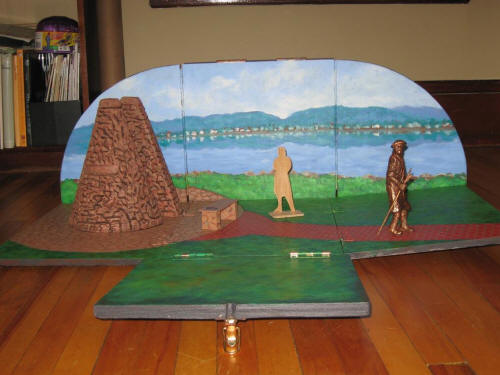|
Monument Honoring
our Scottish Heritage Proposed by the Caledonian Society of
Restigouche

The surrounding area that encompasses
Campbellton, from as early as 1768 was settled and established by
enterprising immigrants from Scotland. Scottish traders George
Walker and Hugh Baillie started an establishment near Walkers Brook,
trading furs and shipping salted salmon. This location would soon
become Campbellton. In 1773 a London merchant John Shoolbred and his
agent William Smith bought out all of Walker's lands. This land
being where Campbellton is located soon changed hands to Samuel Lee
and Shoolbred continued his business on the Quebec side of the
Restigouche. Brothers, Robert and John Adams were among the eight
men Shoolbred brought here from the Aberdeen area of Scotland. These
men along with John Duncan and their families devoted themselves to
the salmon fishing industry at Old Church Point, which is the
current location of Atholville.
In 1794, a Scotsman
from Perth named Alexander Ferguson settled in Martin's Point (now
Campbellton), where his brother Robert joined him two years later.
In 1805, Alexander Ferguson died and Robert inherited his brother's
business, he quickly became the largest merchant and exporter of
fish in Restigouche. Until the 1840s, he shipped between 1,200 and
1,400 barrels of salted salmon per year. He became the most
important landowner in the region and also operated a flour mill and
sawmills that exported hewn wood. Mr. Ferguson constructed his own
boats in the village that now bears the name of Atholville.
Considered the founder of Restigouche County, Robert Ferguson, in
1812 at Old Church Point, erected an imposing residence and store
combined, which was called Athol House, after his birthplace in
Scotland. This was "the first estate permanently established on the
Restigouche". It soon became the business center of the Restigouche.
Athol House property also holds within its bounds the cemetery that
protects the remains of so many of the original settlers, including
the oldest stone in the cemetery belonging to Robert Adams of
Aberdeen, Scotland. New Brunswick became the home for many Scots.
One of New
Brunswick and Canada's most famous regiments was "The King's First
American Regiment" founded in 1776. It was composed mostly of
Highlanders, many of whom fought with their traditional kilts to the
sound of the pipes. The regiment distinguished itself when it
defeated Washington's forces at the Battle of Brandywine. When it
disbanded after the War, most of its members settled in New
Brunswick. A continual influx of immigrants from Scotland and Ulster
meant that by 1843 there were over 30,000 Scots in New Brunswick.
Highlanders and Islanders were highly acclaimed as successful
pioneers, being ideally suited to the harsh conditions and
privations which had to be endured by the first wave of immigrants.
Once established they generally attracted large numbers of followers
from their homeland regions.
In the eastern
Maritimes the timber trade was the crucial factor which determined
where Scots would settle. The fact that so many Scottish Highlanders
settled in the eastern Maritimes during the late 1700s and early
1800s is largely attributable to the relative ease with which they
could be collected by the many timber ships which were then leaving
the Clyde for the Maritimes. Scots had an enormous impact on
Canada's early economic and political development and should be
regarded as a "founding people". Their influence was immense despite
being outnumbered by other ethnic groups. Those immigrants who
arrived after 1759 were mainly Highland farmers who had been forced
off their crofts (rented land) during the Highland and Lowland
Clearances to make way for sheep grazing due to the British
Agricultural Revolution. Before 1815, emigration was discouraged,
but emigration from Scotland to the Maritime Provinces constituted
one of the principal components of the exodus; by 1815 Scots formed
one of the three major ethnic groups there. Most of the emigrants
were unskilled Highland farmers, who gathered in isolated
communities. The Maritimes attracted them because of the opportunity
there to be left alone to pursue the traditional way of life; more
populated and better organized jurisdictions did not provide this
chance.
The names of the
beloved towns they left behind in Scotland were instilled here in
their new home. The towns surrounding Campbellton ring with the tone
of Scotland: Glen Levit, Glencoe, Atholville, Blair Athol, Dundee,
Balmoral and Dalhousie. There is nothing in this locality dedicated
to these remarkable Scots. What they accomplished for this region so
many years ago needs to be honored and remembered. The members of
the Caledonian Society of Restigouche are currently fundraising to
erect a monument designed by sculptor Darren Byers. The design
consists of two cairns with a bronze figure. The figure would be
dressed in Traditional Scottish dress. The monument would be
pointing to Scotland
See
http://restigouchescots.ca/
for more information. |
